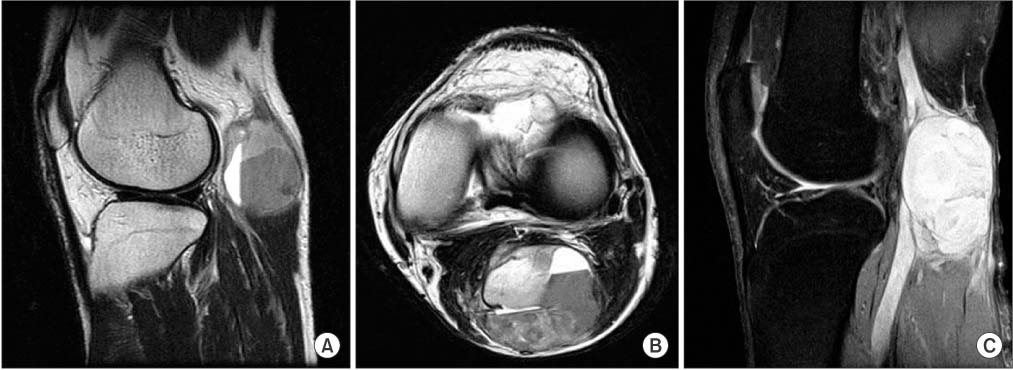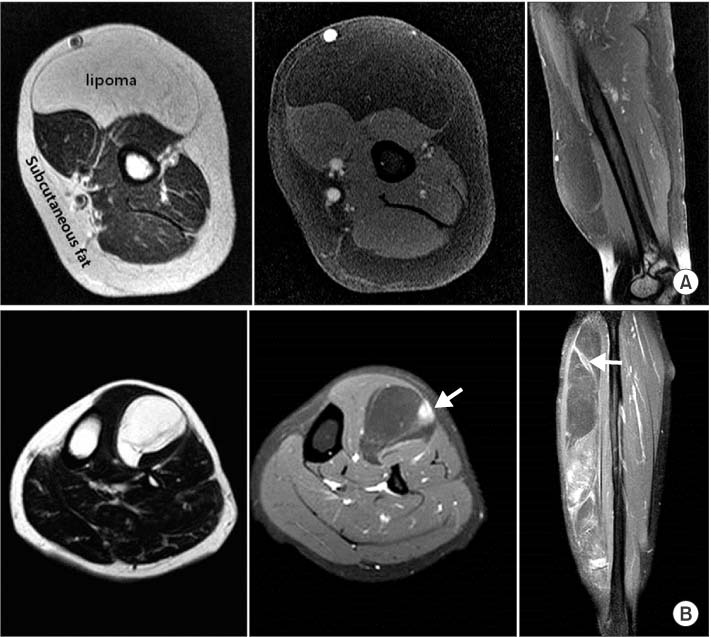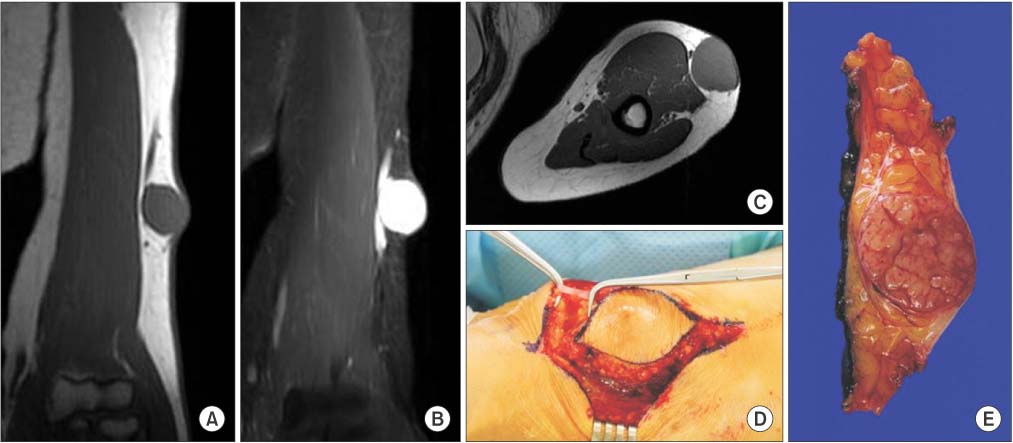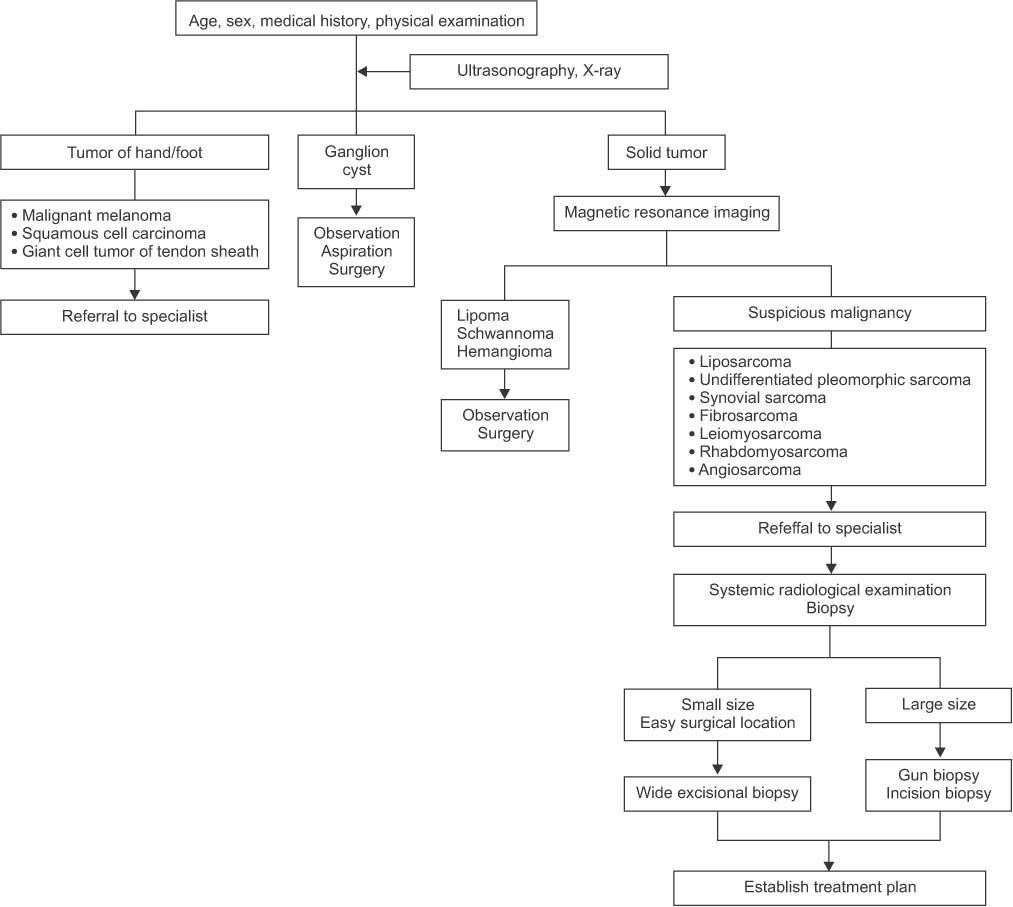J Korean Orthop Assoc.
2015 Aug;50(4):269-279. 10.4055/jkoa.2015.50.4.269.
Diagnoses and Approaches of Soft Tissue Tumors for Orthopaedic Non-Oncologists
- Affiliations
-
- 1Orthopedic Oncology Clinic, National Cancer Center, Goyang, Korea. ostumor@ncc.re.kr
- KMID: 2035863
- DOI: http://doi.org/10.4055/jkoa.2015.50.4.269
Abstract
- Soft tissue tumors are classified into benign and malignant on the basis of the patient's age, medical history, physical examination, pathological and radiologic examination. We have to caution against misdiagnosis of malignant tumor which can delay the treatment time. Lipoma, schwannoma, hemangioma, and ganglion cysts are common benign tumors, usually of small size and are often located in the superficial layer. Although it may be suspected as a benign tumor, performing contrast-enhanced magnetic resonance maging is preferably advantageous. Liposarcoma and undifferentiated pleomorphic sarcoma, the most common malignant soft tissue tumors, usually occur after middle age; rhabdomyosarcoma is usually presented in children and synovial sarcoma often occurs at a younger age. The magnetic resonance (MR) signal intensity of lipoma shows uniformity with subcutaneous fat, sarcoma should be suspected if it has a contrast-enhanced and non-fat-suppressed part. The MR signals of ganglion cysts show homogeneous and same signal intensity with joint fluid and urine, while the liquid containing sarcoma, like synovial sarcoma, is characterized by heterogeneous signal intensity and contrast enhancement. If surgery is performed, an incision should be made in the longitudinal direction of the limb and the excised tumor should be sent for pathology analysis. When the macroscopic finding of the tumor during surgery is different from the expected diagnosis, the operation should cease with biopsy only or the small superficial tumor can be excised widely if possible. The transfer should be considered unless you can be sure of a benign tumor in hands and feet of children. When diagnosed as malignant tumors, patients should be provided with sufficient information that can lead them to a musculoskeletal tumor specialist.
MeSH Terms
Figure
Cited by 2 articles
-
Intramuscular Giant Lipoma of the Anterior Compartment of the Ankle: A Case Report
Min Gu Jang, Jae Hwang Song, Jin Woong Yi, Dae Yeung Kim
J Korean Foot Ankle Soc. 2020;24(3):124-127. doi: 10.14193/jkfas.2020.24.3.124.Intramuscular Myxoma of the Foot: A Case Report
Woo Jin Shin, Choong Sik Lee, Cheol Mog Hwang, Min Gu Jang, Jae Hwang Song
J Korean Foot Ankle Soc. 2023;27(1):35-38. doi: 10.14193/jkfas.2023.27.1.35.
Reference
-
1. Fletcher CD. The evolving classification of soft tissue tumours: an update based on the new WHO classification. Histopathology. 2006; 48:3–12.
Article2. Fletcher CDM, Unni KK, Mertens FE. Pathology and genetics of tumours of soft tissue and bone. World Health Organization classification of tumours. Lyon: IARC Press;2002.3. Coindre JM. New WHO classification of tumours of soft tissue and bone. Ann Pathol. 2012; 32:S115–S116.4. Jemal A, Siegel R, Ward E, et al. Cancer statistics, 2006. CA Cancer J Clin. 2006; 56:106–130.
Article5. Peabody TD, Gibbs CP Jr, Simon MA. Evaluation and staging of musculoskeletal neoplasms. J Bone Joint Surg Am. 1998; 80:1204–1218.6. Peabody TD, Simon MA. Principles of staging of soft-tissue sarcomas. Clin Orthop Relat Res. 1993; 289:19–31.
Article7. Russell WO, Cohen J, Enzinger F, et al. A clinical and pathological staging system for soft tissue sarcomas. Cancer. 1977; 40:1562–1570.
Article8. Beahrs OH, Henson DE, Hutter RVP, et al. Manual for staging of cancer. 4th ed. Philadelphia: Lippincott;1992.9. Fleming ID, Cooper JS, Henson GE, et al. AJCC cancer staging manual. 5th ed. Philadelphia: Lippincott-Raven;1997.10. Enneking WF. Musculoskeletal tumor surgery. New York: Churchill Livingstone;1983.11. Enneking WF, Spanier SS, Goodman MA. A system for the surgical staging of musculoskeletal sarcoma. Clin Orthop Relat Res. 1980; 153:106–120.
Article12. Enneking WF, Spanier SS, Malawer MM. The effect of the anatomic setting on the results of surgical procedures for soft parts sarcoma of the thigh. Cancer. 1981; 47:1005–1022.
Article13. Greene FL, Page DL, Fleming ID, et al. AJCC cancer staging manual. 6th ed. New York: Springer-Verlag;2002.14. Edge SB, Byrd DR, Compton CC, et al. AJCC cancer staging manual. 7th ed. New York: Springer;2010.15. Urakawa H, Tsukushi S, Arai E, et al. Association of short duration from initial symptoms to specialist consultation with poor survival in soft-tissue sarcomas. Am J Clin Oncol. 2015; 38:266–271.
Article16. Stramare R, Beltrame V, Gazzola M, et al. Imaging of soft-tissue tumors. J Magn Reson Imaging. 2013; 37:791–804.
Article17. Aga P, Singh R, Parihar A, Parashari U. Imaging spectrum in soft tissue sarcomas. Indian J Surg Oncol. 2011; 2:271–279.
Article18. Littrup PJ, Bang HJ, Currier BP, et al. Soft-tissue cryoablation in diffuse locations: feasibility and intermediate term outcomes. J Vasc Interv Radiol. 2013; 24:1817–1825.
Article19. Umer HM, Umer M, Qadir I, Abbasi N, Masood N. Impact of unplanned excision on prognosis of patients with extremity soft tissue sarcoma. Sarcoma. 2013; 2013:498604.
Article20. Kang S, Han I, Lee SA, Cho HS, Kim HS. Unplanned excision of soft tissue sarcoma: the impact of the referring hospital. Surg Oncol. 2013; 22:e17–e22.
Article21. Nishimura A, Matsumine A, Asanuma K, et al. The adverse effect of an unplanned surgical excision of foot soft tissue sarcoma. World J Surg Oncol. 2011; 9:160.
Article22. Qureshi YA, Huddy JR, Miller JD, Strauss DC, Thomas JM, Hayes AJ. Unplanned excision of soft tissue sarcoma results in increased rates of local recurrence despite full further oncological treatment. Ann Surg Oncol. 2012; 19:871–877.
Article23. Han I, Kang HG, Kang SC, Choi JR, Kim HS. Does delayed reexcision affect outcome after unplanned excision for soft tissue sarcoma? Clin Orthop Relat Res. 2011; 469:877–883.
Article











